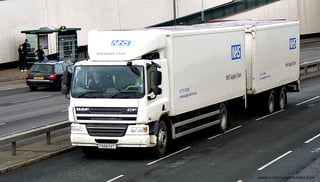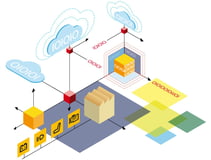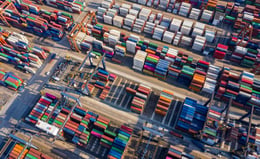How the Internet of Things Increases In-Transit Visibility
Nick Ostdick - March 31, 2016

In our previous few blog entries, we’ve explored how technology has impacted today’s globalizing supply chain industry and how supply chain planners and managers can leverage this technology in intelligent, cost-effective decision-making. The wealth of 'smart' supply systems makes it easy to connect people, processes, and data – the backbone of any efficient supply stream – and The Internet of Things (IoT) adds a vital fourth element to the equation that planners should leverage to increase supply efficiency and in-transit visibility.
The IoT is essentially what it sounds like: the network enabling of smart devices – computers, tablets, and software – that communicate and coordinate supply chain processes and data using the internet – for context, imagine several iPhones sending automated text messages to each other 24/7. According to the supply chain research group Gartner, there will be roughly 6.4 billion connected devices in use worldwide in 2016, with a projected 20.8 billion by 2020.
The rapid pace of connectivity – 5.5 million new things each day by the end of 2016 – should be a supply chain planner’s dream in terms of increasing transparency and visibility across all points of the supply chain process, especially when it comes to transportation and warehousing of products.
Enhancing Overall Visibility
In an era before the IoT, something as simple as a traffic jam could severely hamper supply chain efficiency. An order would be processed, a delivery scheduled created, and a truck would be sent out only to run directly into a traffic jam, delaying the delivery and potentially creating a bottleneck in the supply chain that could result in a loss of revenue, resources, and return on investment (ROI). Until now, there would be no way of assessing possible route obstructions or the potential for delivery disruptions, and supply chain planners would have to make their best possible guesses about associated transportation costs, including fuel and maintenance expenditures.
However, with the advent of the IoT, planners and managers can now use multiple streams of real-time data and analytics to better predict fuel consumption and costs, wear and tear on equipment, and GPS and RFID technology to track shipments, plan effective routes, and troubleshoot potential obstacles for on-time delivery such as traffic jams, construction, and weather-related events.
 Never before have supply and transportation chain variables been able to be so closely monitored from end-to-end, departure to delivery. The IoT of things allowing planners to not only track shipments from start to finish, but also to use automation to schedule delivery, use systems to monitor inventory levels and demand, schedule shipments on their own with accurate estimates for arrival times, and monitor the freight conditions with which supply is delivered along with elements like temperature and other sensory input.
Never before have supply and transportation chain variables been able to be so closely monitored from end-to-end, departure to delivery. The IoT of things allowing planners to not only track shipments from start to finish, but also to use automation to schedule delivery, use systems to monitor inventory levels and demand, schedule shipments on their own with accurate estimates for arrival times, and monitor the freight conditions with which supply is delivered along with elements like temperature and other sensory input.
All of this data, delivered in real-time, allows for increased in-transit visibility and for planners and managers to easily share this information with manufacturers, distributors, and retailers to foster communication and collaboration from the assembly line to the sales floor.
Breaking It Down
Enhanced overall end-to-end supply chain visibility and transparency sounds good, but how exactly does the IoT provide such visibility? While we just outlined these benefits in a very general way, let’s look at a few concrete value-added propositions the IOT can provide to supply chain logistics.
- Detailed Tracking: Being able to track shipments – and their accompanying conditions, such as temperature and other environmental variables – from door-to-door not only provides supply chain planners with a window into how partners or vendors handle shipments, but also allow for the evaluation of selected routes and the overall efficiency of freight carriers. The capacity for detailed analytics on the cost-efficiency of freight will have a ripple effect for supply chain planners interested in creating as streamlined a supply chain system as possible.
- Managing Warehouse Stock: Imagine a supplier schedules a delivery of a product to a customer using inventory readings taken from the close of business the day before – a somewhat common practice prior to the IoT. The data shows inventory levels will be adequate to fill the order, but an unforeseen disruption overnight means reduced inventory for that shipment for which the planner was unaware. While this used to lead to a costly supply disruption, the IoT provides suppliers with automated, real-time reporting on warehouse stock leading to the ability to rapidly adjust plans or shipments. Gone are the days of hoping the product is available for shipping and arrived are the days when intelligent planning systems can use automated triggers in order to make decisions on whether or not to order additional product, adjust shipment pick up times, or expedite orders.
- Fuel cost reduction: Utilizing GPS and RFID technology, along with sensors and onboard computing, suppliers can track, analyze, and share real-time data about fuel consumption and equipment maintenance to leverage best practices when it comes to freight and shipping. The ability to monitor fuel prices throughout a specific region is also beneficial in deciding the most cost-effective time and mode to schedule shipments, and to provide transportation partners with the most up-to-date data possible on fuel and other transportation costs.
IoT Adds Value Beyond the Numbers
As the global supply chain becomes dependent on technology and automated systems that essentially remove some of the human element from the equation, it’s important to view the IoT and other technological advances as mere tools to enhance overall manufacturing, supplier, distributor, and sales experiences.
At the end of the day, supply chain logistics and processes are measured and evaluated as best practices to more efficiently serve customers – people – and to ensure products and services are delivered on time and in good order to cement lasting, profitable relationships. Tools like the IoT make it easier to build these relationships and provide customers with the peace of mind required to create partnerships where each party benefits and shares in the growth and prosperity that results from effective business practices.
LATEST POSTS
- Understand Circular Economy in The Manufacturing Industry
- How Can Industry 4.0 IT Integration Be Achieved Smoothly?
- The Significance of Order Sequencing in Discrete Manufacturing
- How to improve your Supply Chain Management: The Power of Control Towers
- Optimizing Human Resource Scheduling in Manufacturing: A Technological Approach



